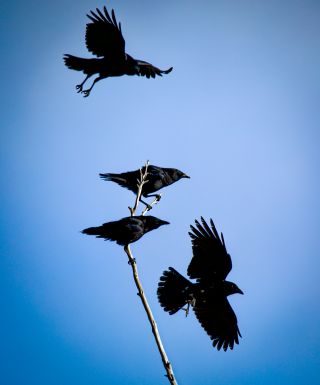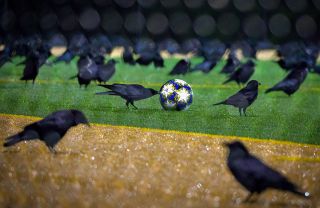KEY POINTS-
- Many people harbor a dislike for crows, often based on myths and negative narratives.
- Crows are highly intelligent birds who culturally coevolved with humans.
- What is remarkable about crows is their curiosity, creativity, and constant observation of other species.

Crows are highly intelligent, sentient, and emotional birds. They live all over the place and I've spent many hours watching them sitting near my home and clearly taking in what was happening around them and playing on the fly while windsurfing here and there. I've also had the pleasure of having crows follow me and my dogs when we were walking or hiking in the mountains outside of Boulder, and on many occasions I was sure they were talking to us and that they knew us well. Crows also are known to make up after fighting and seek consolation, and to grieve the loss of friends and family.
Because of my interest in these fascinating, ever-present corvids, I was especially pleased to learn about Dr. Julie Morley's doctoral dissertation "Crow Cosmopolitics: A Multispecies Walking Ethnography Exploring Crow–Human Coexistential Placemaking." Here's what she had to say about her work.
Marc Bekoff: Why did you do your Ph.D. research on "Crow Cosmopolitics?"
Julie Morley: Crow Cosmopolitics emerged as my dissertation work, after years of being an author and environmental educator, as well as from watching and photographing birds. I have had a special relationship with corvids (crows, in particular). Crows are highly intelligent birds who are culturally coevolved with humans—we are very entangled species, historically and prehistorically. The corvid-human relationship has been deeply intertwined on most continents (except for parts of South America and Antarctica).

Crows are a synanthropic species, which simply means that they tend to live close to humans and adapt to human ways of life. My research explores how we humans might better understand, and adapt to the crow’s ways of life, and why this is important.
MB: How does your work relate to your background and general areas of interest?
JM: I have served as an environmental educator, and in that role, I have explored multispecies relationships through the lens of philosophies sometimes referred to as panpsychism or more recently, animism. In addition, I am an ornithographer, conveying a sense of bird lives through both photography and storytelling. When in the field, I combine both my philosophical perspective and my literal camera lenses to better understand birds. I began to notice crows, and in turn, they noticed me noticing them.
Many people harbor a dislike for crows, often based on myths and negative narratives. I love them. What is remarkable about crows is their curiosity, creativity, and constant observation of other species, especially humans. I have cultivated relationships with families of crows, delving into their enigmatic cultures. This experience has led me to develop a deep interest in the intricate and enduring relationship between crows and humans.
MB: Who is your intended audience?
JM: I want my dissertation to welcome a wide range of readers, not only academics. Because my doctoral work was grounded in transdisciplinary scholarship, my writing is meant to be readable to different people in various disciplines. It is written in a partially poetic style, in the hope that it communicates a sense of being in the field, or of what I call entering “crow spaces” with care, wonder, and respect.
MB: What are some of the topics you weave into your book and what are some of your major messages?

JM: The broader topic examines the complexity of the crow-human relationship in urban and suburban shared placemaking, through the field study of two main hot spots: Portland, Oregon, and Seattle, Washington (and their suburbs). In Portland, there has been a lot of conflict with crows, including some poisonings, but also, some crucial experiments in coexistence that offer hope. In Seattle and Bothell, University of Washington has been a center for crow-human relations, and corvid research. In fact, tourists visit the famous crow roost at UW at Bothell to witness the spectacle of thousands of crows on every surface. Under the guidance of Dr. John Marzluff, researchers have made remarkable discoveries about crow intelligence, cultures, and cognition. His colleagues are currently attempting to record crow conversations during nightly roosting.
My main topics are crow sentience and cultural creativity, what humans can learn through relating to crows, dispelling negative narratives and re-storying the astonishing enigma of crow cultures. I share my experiences in the field and what I learned through interviewing corvid experts, and other scientists and researchers interested in more-than-human sentience and cultures.
MB: How does your work differ from others who are concerned with some of the same general topics?
JM: My work is a bit different because it is grounded in complexity and transdisciplinary studies. In other words, it draws from various fields of study, including arts-based research such as photos and illustrations, philosophy of science, Indigenous scholarship, multispecies studies, and scientific research, as well as ethnographic interviews. I am weaving many insights into my study, expressing them with language and imagery that attempts to convey the complexity, mystery, and sheer wonder of what emerges for me simultaneously.
MB: Are you hopeful that as people learn more about the lives of crows they will treat them with more respect and dignity?
JM: I believe that if people open their minds to the cultural lives of crows, they will discover much to relate to, connect with, and admire. Crows have been our companions for as long as Homo sapiens have walked the earth. We are deeply entangled with crows. Even some of our earliest origin stories contain tales about them. Our culture has coevolved with that of the crows, and recent research has revealed that their cognition has convergently evolved alongside primate cognition.
If you take a moment to observe them on any given day in many urban areas, you will find crows engaging in activities strikingly similar to ours: raising their young, searching for food and shelter, and even entertaining themselves through play (such as ball games and windsurfing!). I firmly believe that when people recognize crows as fellow beings that care, feel, think about others, and plan for the future, they might not only treat them with greater respect but actually begin to consider them as a kind of animal kin or companion.
Those who delve into this and other research about crows may find joy in their antics, gain insights into their enigmatic behaviors, and grow to accept and support their continued presence in our shared environment.


